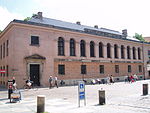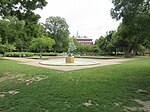Anna Church, Copenhagen
20th-century Church of Denmark churches20th-century Lutheran churchesBrick ExpressionismChurches completed in 1928Churches in Nørrebro ... and 2 more
Churches in the Diocese of CopenhagenLutheran churches in Copenhagen

Anna Church (Danish: Anna Kirke) is a Lutheran church in the Nørrebro district of Copenhagen, Denmark. It was designed by Peder Vilhelm Jensen-Klint, best known for his design of Grundtvig's Church, also in Copenhagen. Built in three stages, it was completed between 1914 and 1928.
Excerpt from the Wikipedia article Anna Church, Copenhagen (License: CC BY-SA 3.0, Authors, Images).Anna Church, Copenhagen
Bjelkes Allé, Copenhagen Nørrebro
Geographical coordinates (GPS) Address External links Nearby Places Show on map
Geographical coordinates (GPS)
| Latitude | Longitude |
|---|---|
| N 55.693 ° | E 12.544138888889 ° |
Address
Anna Kirke
Bjelkes Allé
2200 Copenhagen, Nørrebro
Capital Region of Denmark, Denmark
Open on Google Maps











